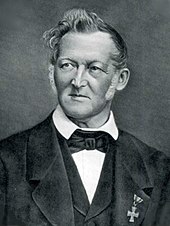Johann Carl Fuhlrott


Johann Carl Fuhlrott (born December 31, 1803 in Leinefelde , † October 17, 1877 in Elberfeld [today in Wuppertal ]) was a German naturalist . He is internationally known to this day because he attributed the skeletal remains found in 1856 in the Neandertal near Düsseldorf - today scientifically known as Neandertal 1 - to a prehistoric person. Finds of the same type later confirmed he was right; this is how the name Neanderthals came about for this type of person. Fuhlrott is therefore considered a pioneer of paleoanthropology , the subject that was his main research area during his time at the Eberhard Karls University of Tübingen .
Life
Johann Carl Fuhlrott was the son of the innkeeper Johannes Philipp Fuhlrott and his wife Maria Magdalena, geb. Nussbaum, who both died when he was ten years old. Therefore, he was raised in Seulingen by his uncle, the Catholic priest Carl Bernhard Fuhlrott († 1839) . In 1835 Fuhlrott married Josepha Amalia Kellner (1812–1850), with whom he had six children.
Fuhlrott studied from 1824 first theology , then natural sciences at the University of Bonn . His studies focused on palaeontology and zoology (with Georg August Goldfuß ), mineralogy (with Johann Jacob Nöggerath ) and botany (with Christian Gottfried Nees von Esenbeck ). Fuhlrott completed his studies with the state examination at the University of Münster . In 1835 he received his doctorate from the University of Tübingen. phil. PhD.
After employment as a teacher at the grammar school in Heiligenstadt and from 1830 at the secondary school in Elberfeld, he became a professor of natural history at the University of Tübingen in 1835. Until shortly before his death he was a teacher at the Oberrealschule Elberfeld, which he also temporarily headed. So far, with over 40 years of service, he was the longest-serving teacher there. This grammar school has had his name since 1986: Carl-Fuhlrott-Gymnasium .
On April 9, 1846, Fuhlrott founded one of the oldest scientific associations in Germany, the Wuppertal Scientific Association . In 1862 he founded the Wuppertal Animal Welfare Association , which still exists today, under the name Wupperthaler Verein zur Schutz der Thiere . Fuhlrott had been a member of the Freemasons Association since 1846 . Until his death he belonged to the Elberfeld Lodge Hermann for the land of the mountains .
The fossil man from the Neandertal ... (1865) is one of his main works . Fuhlrott had immediately ascribed the special characteristics of the bones given to him by a quarry owner ( bulges over the eyes , unusually thick ridges and ridges as starting points for extremely strong muscles) to an individual "from the prehistoric era", two years before Darwin's important work On the Origin of Species . When he put his interpretation up for discussion at a meeting of naturalists in 1857, it was not taken seriously by the scholars; even more, Fuhlrott found their reaction extremely disheartening. In his first written report, he resignedly concluded that he would “gladly refrain from any attempt at propaganda for my convictions”.
The Fuhlrott Museum , a natural history museum in Wuppertal (closed since 2008), was named after the researcher. Schools in Wuppertal , Mettmann , Leinefelde and Erkrath , where the Neanderthal man was found, bear his name. In his native town of Leinefelde, a memorial was erected in honor of Fuhlrott in the street named after him.
Works
- Jussieu's and De Candolle's natural plant systems, developed according to their principles and compared with the plant families of Agardh, Batsch and Linné, ш so -as with the Linnaeus sexual system. For lectures and self-teaching, Bonn: Eduard Weber, 1829
- Contribution to the systematics in natural history, with special consideration of the plant systems , 1833
- The plant kingdom and its metamorphosis , Elberfeld school program, 1838
- The Wisperthal and the Whisperwind. Annual report natural Ver. Elberfeld IV, 1863 (co-editor)
- The fossil man from the Neanderthal and his relationship to the age of the human race. Duisburg: Falk & Volmer, 1865 ( digitized and full text in the German text archive )
- Human remains from a rock grotto in the Düsselthal: a contribution to the question of the existence of fossil humans. Duisburg: W. Falk & Volmer, 1865
- The caves and grottoes in Rhineland-Westphalia; together with a description and plan of the newly discovered magnificent Dechen Cave , Iserlohn 1869 ( digitized version )
- Guide to the Dechen Cave . Iserlohn: J. Baedeker 1869. ( digitized version ), 2nd edition 1873 ( digitized version )
literature
- Willy Bürger: Fuhlrott, Johann Carl. In: New German Biography (NDB). Volume 5, Duncker & Humblot, Berlin 1961, ISBN 3-428-00186-9 , p. 724 ( digitized version ).
- Manfred-Guido Schmitz (Ed.): Sensation in the Neandertal. Johann Carl Fuhlrott and the 150 year old bone finds from the " Feldhofer Grotto " . Reprint of the first publication from 1859. Self-published by M.-G. Schmitz, Kelkheim / Taunus 2006
- The Neanderthal man and his discoverer: Johann Carl Fuhlrott and the history of research Mettmann. Neanderthal Museum, 2001
- Helmut Godehardt: Johann Carl Fuhlrott was born in Leinefelde 200 years ago. In: EJb 11 (2003), pp. 229-240
Web links
- Literature by and about Johann Carl Fuhlrott in the catalog of the German National Library
- Rhineland Regional Association: Johann Carl Fuhlrott (1803–1877): pioneer and teacher of natural history. (PDF file; 74 kB)
Individual evidence
- ^ Tierschutzverein Wuppertal, history
- ↑ Freemason magazine Humanity 2/2004
- ^ School portal Thuringia, Johann-Carl-Fuhlrott-Schule
| personal data | |
|---|---|
| SURNAME | Fuhlrott, Johann Carl |
| BRIEF DESCRIPTION | German naturalist |
| DATE OF BIRTH | December 31, 1803 |
| PLACE OF BIRTH | Leinefelde , Thuringia |
| DATE OF DEATH | October 17, 1877 |
| Place of death | Elberfeld (now part of Wuppertal ) |
